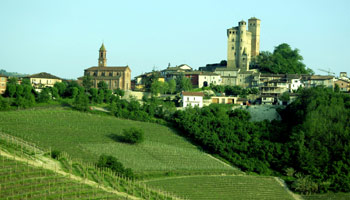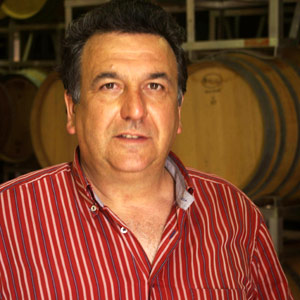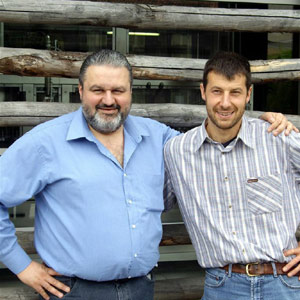Barolo and Barbaresco - The Latest
Article and photos © by Tom Hyland
 |
| Nebbiolo vineyards below the town of Serralunga d'Alba. This commune performed brilliantly with its 2004 Barolos. Photo © 2008 by Tom Hyland |
I recently traveled to Italy - my 35th visit to this wonderful country - and was able to sample the latest releases of the great red wines of the Langhe area of the Piemonte region. These new offerings - the 2005s from Barbaresco and the 2004s from Barolo - are first-rate wines, especially those from Barolo, as 2004 is clearly a great vintage, one of the finest of the last 20 years.
Along with the morning tastings of these wines in Alba, I was also able to visit numerous producers and experience vertical tastings of particular bottlings of Barolo as well a retrospective of more than 50 wines from Barolo and Barbaresco from the excellent 1998 vintage, a year that has been too often ignored in the discussion of recent vintages of this area.
Combine that with some wonderful lunches and dinners in the area (Antinč in Barbaresco, Trattoria La Libera in Alba and a charming newcomer, Profumo Divino in Treiso) and I have come back filled with more passion and excitement about this area than ever before!
Barbaresco
The 2005 Barbarescos were introduced at this tasting and the wines showed very well. 2005 was a very good vintage that probably will suffer in comparison to 2004, as the wines from that year are powerful and have the potential to age for decades. The 2005s are not as intense; yet display slightly higher levels of acidity with plenty of bright fruit.
Barbaresco of course is produced from 100% Nebbiolo - just as Barolo - yet Barbaresco constantly has to take a back seat to Barolo for several reasons. One reason is quantity, as there is only about one-third as much Barbaresco produced as Barolo. Another reason - and the one that probably influences more people - is the image of the two wines. Decades ago, Barolo was dubbed "The King of Wines" and the title has stuck; its regal identity has given Barolo a worldwide identity. If Barolo is the king, then Barbaresco is either the queen or the little brother; the wines generally do not age as long as Barolo and usually do not have the power of that wine; much of this has to do with the lighter soils of Barbaresco that tend to produce wines of less strength and certainly less forceful tannins.
Yet Barbaresco can age well, with most vintages being at their peak in 10-12 years, with a few special vintages yielding wines of even greater aging potential. While this is a shorter time frame than Barolo, the fact of the matter is that Barbaresco does need some time in the bottle to show its true identity. But Barbaresco, generally speaking, is also a wine that is more approachable than Barolo, as the tannins are lighter. So while Barbaresco may never gain the fame of Barolo, the quality is very high and getting better all the time and the wine is often a better choice for pairing with a variety of foods.
The 2005 Barbarescos should be at their best in 7-10 years and can hold for another 5 years or so after that, thanks to the acidity levels. Many of the finest examples I tried were from the town of Treiso, one of the three communes east of Alba where Barbaresco can be produced. The top wines from here included the "Cichin" from Ada Nada, a gorgeous traditional wine that is among my favorite Barbarescos every year; the "Maracarini" and "Nervo" bottlings from Pertinace, a very underrated producer; the "Pajoré" from Rizzi, a classic offering with pinpoint acidity and rich fruit and the "Rombone" from Fiorenzo Nada, a great representation of the power and elegance of Barbaresco.
 |
| Aldo Pola, winemaker at Fontanabianca. His "Sori Burdin" is one of the best of the 2005 Barbaresco. Photo © 2008 by Tom Hyland |
From Neive, the Fontanabianca "Sori Burdin" was another excellent bottling from this top producer; there is a dazzling array of flavors on the palate (cherry, currant, fig and tobacco) and the wine is beautifully balanced. Also impressive were the "Serra Boella" from Sergio Barale and the Tenuta San Mauro, along with the Domenico Filippino "Sori Capelli", which was one of the finest of the 2005 Barbarescos I tasted all week. Each of these wines was from Neive, where the quality was a bit uneven, but generally good. Most of the wines from Neive were made in a style that favored a traditional approach over the fashionable international style.
As for the wines from the town of Barbaresco itself, the approach is varied, with some producers sticking with the classic style while others sought out a more modern direction with noticeable small oak aging. Taste and style are up to the individual of course; I can appreciate wines with various winemaking approaches as long as balance is the key, yet I do confess to preferring the traditional style much more often. Unfortunately, a few producers in Barbaresco tend to play up the new oak a bit too much, in my opinion. Perhaps these vintners feel as though they need to make a riper, oakier style of wine to gain attention from certain influential wine publications, but the wines sometimes lose the soul of Barbaresco.
My job here is not to criticize, so I never mention wines I don't like - after all, it's only my opinion; besides, there are too many good wines to talk about. So let's focus on the best examples from the town of Barbaresco, which included the Cantina del Pino; Poderi Colla "Roncaglie" (always one of my favorites); Castello di Verduno "Rabaja" and the Cascina Morassino "Morassino", which offers lovely perfumed aromas and a long finish with excellent fruit persistence. Their other bottling from the "Ovello" vineyard is a touch lighter, but beautifully polished and a classic representation of Barbaresco; this producer certainly deserves to be more famous!
Barolo
So many people love Barolo, but I doubt many truly understand the identity of this wine. Though every offering of Barolo is produced from 100% Nebbiolo, there are very distinct characteristics found in bottlings that originate from different towns, as with La Morra or Monforte d'Alba. These varying styles largely depend on the soil types; those from vines planted in the younger, lighter soils La Morra, Barolo or Verduno are elegant with perfumed aromas and more polished tannins, while the examples of Barolo from Monforte d'Alba, Castiglione Falletto or Serralunga d'Alba with their older, thinner soils are more deeply concentrated with more intense tannins. These latter wines need more time to round out and settle down than their counterparts.
What is so exciting about a vintage such as 2004 is that the true characteristics of these wines emerge in this great year. The weather was relatively cool throughout the growing season, which allowed for excellent ripening and ideal conditions for preserving the grapes' natural acidity. The results are spectacular as the wines have tremendous fruit aromas (much deeper than usual) with a wonderful backbone of lively acidity and balanced tannins. When I asked Pietro Ratti, owner of the Renato Ratti estate in La Morra, if these wines could age for 20-25 years, he replied, "Oh yes. I think perhaps even 40 years in some cases." This quote sums up the aging potential for these wines as well as any quote I heard from the area's vintners.
It's difficult to know exactly where to begin, as there were so many outstanding 2004 Barolos. The Luigi Einaudi "Cannubi" is another success from this ultraconsistent producer. The wine has gorgeous aromas of cherry, truffle and orange peel and offers a graceful finish. Also from the commune of Barolo, the Virna "Sarmassa" is quite floral and has a rich mid-palate and a lengthy finish with great fruit persistence.
The examples from the commune of La Morra were as polished and as rich in fruit as ever; standouts here included the Mario Marengo, the Revello "La Conca" (this made in a modern style), the Tenuta L'Illuminata "Tebavio" and the Mario Gagliasso "Torriglione", another modern style Barolo with a big burst of fruit on the finish and beautiful red cherry and licorice flavors. The Renato Ratti bottlings are always excellent representatives of the La Morra style; both the "Marcenasco" and the "Conca" bottllings are extremely elegant wines with subtle spice and oak. These are almost approachable now, but wait another few years to appreciate their complexities.
Arguably my top selection of the 2004 La Morra Barolos is the "Bricco Francesco" from Rocche Costamagna. This is the top Barolo from this estate and the 2004 features textbook aromas of truffle, orange peel, dried cherry and red roses, a lengthy finish and vibrant acidity. This is a great example of harmony in a Barolo, as all the components come together to create an elegant, complex, deeply flavored wine that should age for 15-20 years.
In many years, the Barolos from Monforte d'Alba offer the most imposing performance (this was certainly true for the 2001 vintage, another great year) and the 2004s as a whole are quite remarkable. The "Bussia" from Monti has aromas of cedar, orange peel and truffle and a huge finish. This underrated producer has been performing beautifully as of late and also made an excellent Barolo normale in 2004. A real surprise for me was the "Giblin" bottling from Gemma, which offered lovely perfumed aromas, great fruit persistence and a graceful, elegant finish. This is another 15-20 year wine. Also noteworthy from Monforte d'Alba is the Mauro Veglio "Castellero"; the Tenuta San Rocca "Vigna San Pietro", with tons of fresh fruit; the Aldo Conterno "Colonello" (all of his 2004 Barolos are excellent or outstanding) and the Fratelli Alessandra "Gramolere". Elio Grasso produced two noteworthy 2004 Barolos from their estate vineyards in Monforte: the "Casa Maté" with notes of tar and orange peel and very good concentration and the "Chiniera", a truly outstanding wine with lovely aromas of red roses, tar and caramel and big fruit on the lengthy finish. Both of these wines were aged solely in large oak and will drink well for at least 15-20 years, a testament to excellent work in the vineyards and in the cellar by Gianluca Grasso, the son of Elio who serves as winemaker.
But my choices as the finest collection of 2004 Barolos as a whole are the wines from Serralunga d'Alba. Read enough articles or books on Barolo and you'll probably decipher from the author that the crus (single vineyards) of Serralunga are just not as famous as those from La Morra (such as Brunate or La Serra) or Barolo (Cannubi or Sarmassa); thus the wines are probably not as good. Well don't believe everything you read; while the crus of Serralunga are not as well known as others in the Barolo area, they are excellent sites and yield grapes of great concentration, resulting in long-lived wines of great structure. Renowned Italian journalist Franco Ziliani writes, "Serralunga d'Alba represents the spirit and essence of true Barolo." I agree with him wholeheartedly!
The producers here outdid themselves in 2004, most notably Massolino, with a beautifully balanced normale bottling (all Serralunga fruit) and a deeply concentrated, very spicy bottling from the "Margheria" vineyard. This is another traditional producer, as only one of their Barolos - "Parafada" - receives any aging time at all in barriques (and even that will change as of the 2007 vintage, when it will be aged entirely in large oak). If you are seeking classic Barolo, look no further than Massolino.
 |
| Matteo Ascheri and his winemaker, Giuliano Bedino. Ascheri produced two sublime bottlings of 2004 Barolo from the Sorano vineyard in Serralunga d'Alba. Photo © 2008 by Tom Hyland |
The Ascheri "Sorano" bottling has a nice blend of spice and fruit and is quite lovely, while the "Coste e Bricco" bottling, from the best parts of the "Sorano" site offers more depth of fruit, a touch more oak and great intensity of fruit. These are among the supplest of the 2004 Barolos from Serralunga. Also recommended from this commune are the classically styled "La Rosa" and the "Serralunga" bottlings from Fontanafredda; the Serralunga bottling from Giovanni Rosso, with expressive wild strawberry fruit; the Mauro Sebaste "Prapo", which features polished tannins, excellent fruit persistence and beautiful acidity and the Luigi Pira "Margheria", which offers layers of fruit and excellent compexity.
By now, you've gotten the idea about the quality of Barolo from Serralunga d'Alba from the 2004 vintage; let me also mention the outstanding wines from three other Serralunga producers. Ettore Germano made two cru bottlings in 2004: "Prapo" and "Cerretta"; both are deeply concentrated with the former having a bit more intensity. Guido Porro, whose Barolos were not familiar to me, succeeded admirably with his "Vigna Lazzairasco" and "Vigna S. Caterina" offerings which have plenty of spice and are beautifully structured for aging (especially the latter). Finally, the Cascina Cucco bottlings from "Vigna Cucco" and "Cerrati" vineyards were among the very best I tasted all week. The former is more fruit-oriented in its aromas with notes of red cherry and red licorice, while the latter offers more herbal, spicy notes of coffee and cumin. Both offer excellent depth of fruit and are beautifully styled for 20-25 years of aging. These may be difficult to come by upon their release later this summer or early fall, but they are well worth the search.
In short, I can't remember a Barolo vintage when I awarded so many 5-star (outstanding) ratings. Several of the above reached that level and there are several dozen more that made the grade, while there are just as many 4-star (excellent) wines. I will be publishing a special 2004 Barolo guide very soon, as part of my newsletter, Guide to Italian Wines. While a yearly subscription is $40, this special issue will cost only $10 and will feature reviews of more than 125 Barolos from the 2004 vintage. To learn more about receiving your copy, please contact me at the link below.
In future columns, I will talk more about the beautiful 1998 vintage for Barolo as well as some excellent restaurants in this area. You will also be able to learn more at my website: www.learnitalianwines.com
May 2008
To contact Tom Hyland, visit his Website, "Learn Italian Wines," www.learnitalianwines.com or write him at thwinewriter@comcast.net




